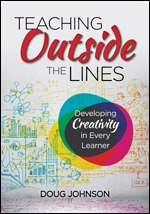Pace of change and diversity of skill levels
 Wednesday, October 24, 2012 at 06:17AM
Wednesday, October 24, 2012 at 06:17AM In almost every workshop I give for educators that involves technology skills, I find a growing distance between the most and least skilled in the group*. While this has always been somewhat true, it feels like the gap is growing wider every year.
My theory is that there is a direct correlation between the rate of change and the distance between the most and least technologically-skilled in any random group. I've tried to show this graphically:

and

So my ongoing question lately has been: "How does one differentiate instruction in technology inservices for teachers?" Here are strategies I've used:
- Aim at the middle. Pitch the old workshop at the "average" attendee. Then half the class is bored and the other half is frustrated. Everyone being equally unhappy is achievable if you work at it.
- Ask for only skill-similar participants. If your workshop description states the needed skill level and clearly articulates its objectives, you have a better chance of getting a group with a homogenous skill level. Although plenty of people don't read session descriptions, may not have a choice in attending, or over/under estimate their own abilities.
- Use small groups. The activities in every workshop I give are group activities. Your chance of getting a mix of skill levels is pretty good in a small group and the more skilled can help the less skilled. I do advise everyone to "sit beside someone who looks smarter than you are." For some of us, that is pretty easy.
- Design activities with levels. Good workshop activities are like onions and ogres - they have layers. Start with a basic accomplishment, but add a few things that may challenge those who already know the basics. (Everyone has to create a motivational poster that defines a vocabulary word; if you have time, use photo-editing software to modify the illustration so it looks artsy, change the color of the frame, and choose a non-standard font.)
- Design multiple activities or multiple sets of outcomes and groups. Marti, one of the bright pennies working as a technology integration specialist in my department this year, helped new iPad recipients self-assess and then divided them into skill-level groups at the very beginning of the afternoon-long workshop. He worked personally with the least skillful group, set his assistant to working with the middle group, and left the advanced group with video tutorials, a list of objects, and each other for help. I was impressed at how well this worked.
We at least give lip service to providing differentiated instruction in our K-12 classrooms. Given the pace of change, the ever-widening skills gap, and increasing importance of good technology skills among all staff, we need to take customizing inservices more seriously as well.
Any differentiation strategies for inservices that have worked for you?
* Never, however, as bad as the teachers Scott Mcleod has encountered:
... I continually run into significant numbers of educators who still don’t know how to work their Internet browser. They struggle with copying and pasting. They get confused just clicking between 2 or 3 different browser tabs. They don’t conceptually understand the difference between their browser’s Google search box and the box where they can actually type in the URL and get there directly. They have no idea that they can right-click on things like hyperlinks or images. And so on… [And this is just the Internet browser. I'm not even talking about individual software programs or online tools.]
OK, no digs at Iowa, although it's tempting.








Reader Comments (3)
I wish we were as smart as Marti back in my former district. When we did the first iPad 1:1 training sessions we grouped teachers according to a self-assessment and rotated them all through the same training sessions. What we got was a huge group of low-end users who were frustrated, and growing more so as the day progressed. It was no treat for me to get through Evernote in 40 minutes either. A friend of mine who was in the high end group spent the day playing on her own as she moved through the stations. We probably should have assigned more staff to the lower group and empowered the highest group to take off on their own and find their own cool things to share with those in their team (of differing skill levels). People get trapped in old paradigms of what professional development was...especially when planning is done in groups.
Food for thought for me.
Hi Nathan,
Personally, I am always amazed at how bad many workshops and presentations are at education conferences. We certainly don't practice what we preach. My sense also is that until an educator experiences a type of instruction or learning opportunity as a learner, s/he is unlikely to use it with kids.
Another iPad workshop this afternoon even more differentiated according to reports!
Doug
tancrmar e3d3fd1842 https://stonerx.me/decanifo